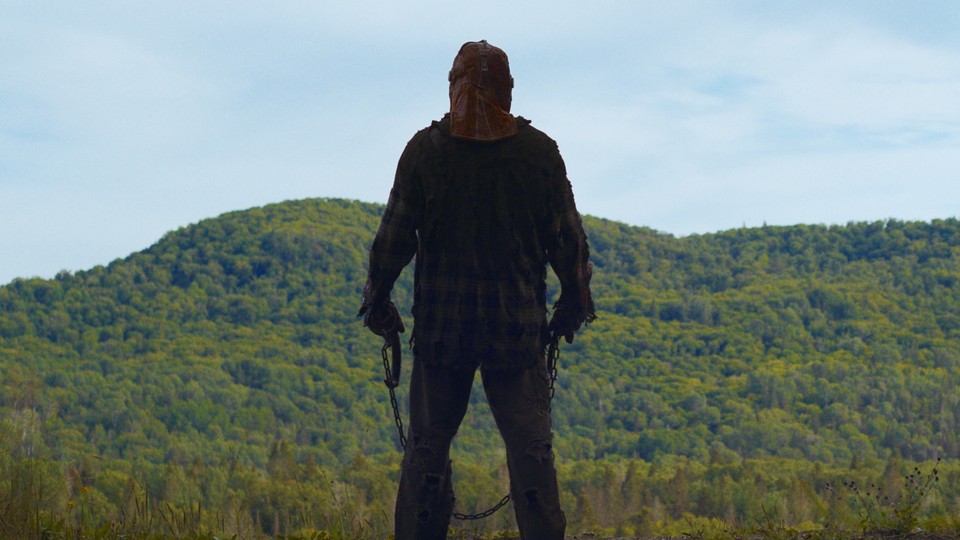A Slasher Movie That Forces You to Slow Down and Think
4 min read
In a Violent Nature is a slasher film designed, as most slasher films are, to unsettle and distress. It follows a group of teenagers who unintentionally disturb a grave, awaken a monster, and then get hunted through the woods by this mute, superhuman creature. The plot is stubbornly formulaic. But its presentation is somewhat radical, to the extent that I feared I was settling in for the most terrifying movie experience of all: an empty genre exercise, one that’s more interested in style than in substance.
The writer-director Chris Nash runs the risk of seeming pretentiously self-aware in his feature debut, which is in theaters this week and is worth watching if you have a high enough tolerance for gore. In a Violent Nature is a horror film about the experience of watching a horror film; it prods the audience to consider the artificiality of genre classics such as Friday the 13th, which it is consciously aping and subverting. In almost every slasher, the camera tends to stick with the victims as they navigate frightening scenarios and are picked off by a mostly unseen villain. But In a Violent Nature is told from the point of view of the silent predator as he tromps around the Ontario wilderness in search of his next quarry.
The movie essentially raises the question: What is the killer doing for most of a slasher film’s running time? If you’re watching a Halloweenor a Friday the 13th, in which the personality-free antagonist is more a force of nature than a scheming rogue, the murderer is on-screen for only a handful of minutes. Michael Myers and Jason Voorhees are nightmarish, but they’re not exactly leading men; the films they “star” in are always, by necessity, centered on the people they’re chasing. Nash starts things off differently, focusing on an old abandoned locket, the sort of detail many viewers might not notice. We then see a hand snatch the locket away, and it’s quickly clear that this action has disturbed a burial ground, because out of the earth pops a large, desiccated man named Johnny (played by Ry Barrett).
As in any such horror film, Johnny has plenty of overactive teenagers to stalk, and all seem to be wrapped up in the typical interpersonal dramas that define these stories. But the audience only overhears snippets of conversations, and has to guess at what flirtations or tensions might be motivating the campers to split off, go swimming, or do anything else that leaves them vulnerable. That’s because the viewer stays with Johnny, the camera usually hovering above his shoulder as he lurches through the trees. His movements seem almost aimless—until he crosses another teen’s path and we’re treated to a scene of involved and intense maiming.
The film most recalls Gus Van Sant’s meditative and upsetting 2003 film, Elephant, which presented a school shooting as an abstract visual exercise, following teenagers as they meander through hallways before the plot curdles into something deeply chilling. In Elephant, Van Sant was trying to unpack the mundanity of life, and how the routine can turn unthinkable in an instant. And although Jonathan Glazer’s The Zone of Interesttook a different formal approach (using static, surveillance-like cameras to track the action), that film was similarly intent on creating a banal backdrop for brutality. In a Violent Nature is not nearly so heady, and is steeped in the silliness of slashers, which is why I was worried it would be undermined by its winking nature.
But despite the film’s knowing edge, it’s still really scary to follow a hooded, hook-wielding butcher through the woods, anticipating whatever round of chaos he is about to unleash next. In a Violent Nature judiciously spreads out its kills, but when they arrive, they are extremely nasty, achieved with impressive practical effects and a methodical, straightforward presentation. There are no quick cuts here, no goofy ways of hiding gore from the audience: Nash wants the viewer to engage with the pure terror of what’s going on just as much as he wants them to sit in the tedium of it. The result is a film as worthy as its predecessors—and one of the most unsettling examples of the genre I’ve seen in years.



